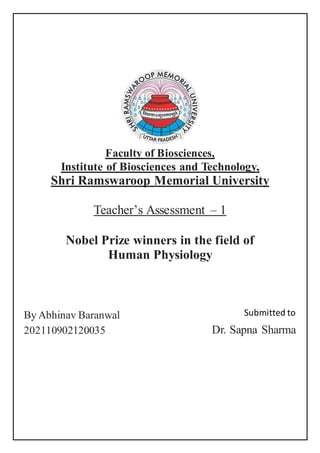
Nobel Prize winners in the field of Human Physiology.docx
- 1. Faculty of Biosciences, Institute of Biosciences and Technology, Shri Ramswaroop Memorial University Teacher’s Assessment – 1 Nobel Prize winners in the field of Human Physiology By Abhinav Baranwal 202110902120035 Submitted to Dr. Sapna Sharma
- 2. Nobel Prize winners in the field of Human Physiology Digestion, it is the phenomenon of breakdown of large complex insoluble food molecule into small, simple, soluble diffusible molecule by enzyme action. Many scientists/Nobel laureates have made exquisite discoveries and findings in the field of digestion and shared their knowledge about the physiology of digestion. Here we will talk about some Nobel personalities who had presented mankind with their discoveries: Ivan Petrovich Pavlov Ivan Petrovich Pavlov was born in September 26, 1849 in Ryazan and died 27th of February 1936 in Leningrad. He was a Russian scientist and physiologist who founded the science ofhigher nervous activity and the study of digestion regulatory mechanisms. He is the founder of the largest physiological schoolin Russia. In 1904 Ivan Petrovich Pavlov got Nobel Prize in Medicine and Physiology “for his work on the physiology of digestion". He stated that the basis of mental activity is physiological processes in the cerebral cortex, according to the conditioned reflex technique. Pavlov's Research in physiology of higher nervous activity, had a great influence on the development of physiology, medicine, psychology and pedagogy.
- 3. Barry J. Marshall and J. Robin Warren Dr. Barry J. Marshall, 54, and Dr. J. Robin Warren, 68 were awarded Nobel Prize in Physiology in 2005 concertedly for their discovery of “the bacterium Helicobacter pylori and its part in gastritis and peptic ulcer ailment”. Up until their discovery in 1982, the long-held view was that spicyfoods orstress caused ulcer trouble. According to the Nobel Foundation, Dr. Robin Warren, a pathologist from Perth, Australia, observed small curled bacteria populating the lower part of the stomach in about 50 ofcases who had their abdomens biopsied. He observed that Inflammation was usually present in the gastric mucosanear where he noticed the microorganisms. Barry Marshall, a co-worker, got interested in Warren’s findings and together they initiated a study of autopsies from 100 cases. Marshall succeeded in cultivating a preliminarily unknown bacterial species – after named Helicobacter pylori – from several of these autopsies. They establish that the organism was present in nearly all cases with gastric inflammation, duodenal ulcer, or gastric ulcer. Grounded on these results, they proposed that this recently linked bacterium caused these conditions. Until that time, so settled was the belief that lifestyle caused ulcers that, indeed with their substantiation, it was delicate for these two experimenters to move the world of H. pylori’s part in ulcer complaint. The H. pylori infection rate among grown-ups in developing countries is well over 80 and it falls between 20-50 in industrialized countries. H. pylori infection is associated with an increased threat of developing gastric cancer, one of the most current conditions world-wide. Ulcers are painful and, if left undressed can lead to severe complications including stomach perforation and bleeding. The discovery of Helicobacter pylori has led to an increased understanding of the connection between habitual infection, inflammation, and cancer.
- 4. John H. Northrop John Howard Northrop, born July 5, 1891, Yonkers, New York, U.S. — died May 27, 1987, Wickenberg, Arizona. American biochemist who took (with James B. Sumner and Wendell M. Stanley) the Nobel Prize for Chemistry in 1946 for successfully purifying and crystallizing certain enzymes, therefore enabling him to determine their chemical nature. Fig: Structure of Pepsin During World WarI Northrop conducted studyonfermentation procedures fit forthe industrial production of acetone and ethyl alcohol. This work led to a study of enzymes necessary for digestion, respiration, and general life processes. At that time the chemical nature of enzymes was unknown, but through his exploration Northrop was able to prove that enzymes obey the laws of chemical reactions. He crystallized pepsin, a digestive enzyme present in gastric juice, in 1930 and establish that it's a protein, therefore figuring the controversy over what enzymes are. exercising the same chemical methodologies, he isolated in 1938 the first bacterial virus (bacteriophage), which he demonstrated to be a nucleoprotein. Northrop also helped isolate and prepare in crystalline form pepsin’s inactive precursor pepsinogen (which is converted to the active enzyme through a response with hydrochloric acid in the stomach); the pancreatic digestive enzymes trypsin and chymotrypsin, and their inactive precursors trypsinogen and chymotrypsinogen respectively. His work led to further understanding ofprotein digestion via pepsin activity.
- 5. Heinrich Otto Wieland Heinrich Otto Wieland, (born June 4, 1877, Pforzheim, Germany — died August 5, 1957, Munich, Germany), German chemist, winner of the 1927 Nobel Prize for Chemistry for his purposefulness of the molecular structure of bile acids. Fig: Molecular Structure of Bile acid Wieland attained his doctorateat the University of Munich in 1901 and remained in that town to educate and carry on his research. He got the job as professor of chemistry at the University of Munich in 1925 and kept that post until his retirement in 1950. Wieland made significant contributions to structural organic chemistry with his findings (1911) that other forms of nitrogen in organic compounds can be detected and differentiated from one another. The coming year he began his research on bile acids, which are produced by the liver. He established that the three acids he'd isolated were steroids of same structure that were related to cholesterol. His subsequent work led him to think that oxidation in living tissues is a matter of removing hydrogen atoms (dehydrogenation) and not of adding oxygen. This hypothesis proved of great significance to physiology, biochemistry, and medicine.